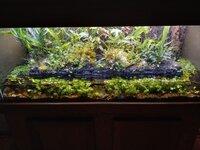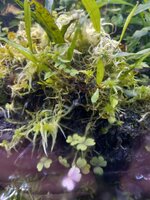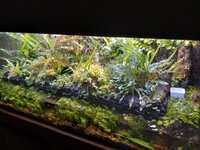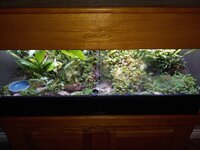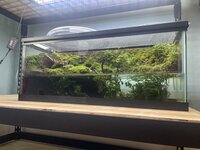Hi Snipologize...
In the past few years I've shared a number of photos of the palladium I built for, and successfully bred shanjing (at least 19 different broods between 2017 and 2022). A few are attached here so you dont need to hund for past postings.
In short, I think yours is off to a good start. If you're getting real shanjing, they are highly terrestrial. A filtered water feature is good for breeding bit doesn't need to be large. My two overarching recommendations are:
1) Replace as most of the hardscape/rock with CorkBark. It will absorb moisture and plants and moss will colonize it (see below). If you intend to breed them, having lush moss or low vegetation (such as the greenhouse oxalis/"shamrocks" you see in my pics) growing over the edges of your water feature will be crucial. Shanjing will indeed lay eggs in water. In my experience though, if you give them moist vegetation or moss hanging above the water, most eggs will be attached there, and the larvae then drop into the water upon hatching. Also, eggs attached to clumps of moss or vegetation are easy to harvest pre-hatch and can be moved to a grow-out aquarium.
2) As to the vegetation, contrary to much of the info on the web, and in my opinion/experience, shanjing appreciate high humidity, and lots of moss and low vegetation. Java ferns grown emersed or even terrestrial (which requires high humidity), lemon button ferns, greenhouse oxalis, and other cheap low-growing, humidity living plants are best...your vivarium is kind of bare...load it up with moss, a few big corkbark sheets and plants! I would even go so far as to recommend keeping your new arrivals on moist brown paper towels (changed every 3-4 days) for a couple months until you can grow some plants or get a well-started moss slurry to take off in there.
Two other great things about shanjing, they are not secretive, at least in a well planted vivarium/palladium. Mine are commonly out and visible by day. They are also much more tolerant of warm temps than other newts. In the summer, my vivarium commonly gets to 80F, and (while I would recommend avoiding temps over 80F) I've measured temps in there as high as 85F and the shanjing are active, and eat well. Warmish temps, humidity, and good light will promote your vegetation and moss to grow fast as well. Feel free to PM me if you'd like more tips.

